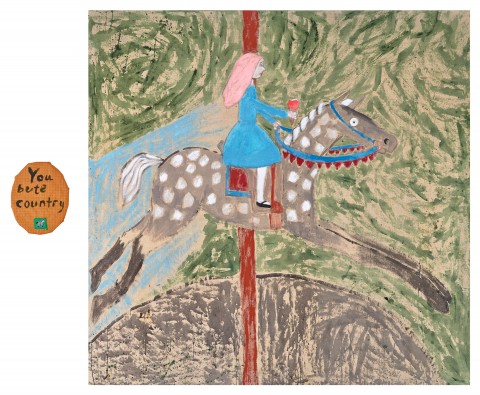YOU BUTE COUNTRY, 2003
JENNY WATSON
i. oil on linen
ii. oil on Thai silk
i. 204.0 x 208.5 cm
ii. 25.5 x 20.5 cm
i. signed, dated and inscribed with title verso: JENNY / WATSON / 2003 / “YOU BUTE / COUNTRY”
ii. signed and dated verso: jenny / watson / 2003
Anna Schwartz Gallery, Melbourne (label attached on stretcher bar verso)
Shannon Bennett, Melbourne
With expressive faux naiveté, Jenny Watson’s paintings display a Punk irreverence and a radical commitment to female experience and personal narrative. In You Bute Country, a primly dressed girl sits atop a carousel horse, holding an ice-cream while she surveys the roughly sketched landscape. While snippets of language, in the form of vernacular aphorisms were often added into the composition of Watson’s early paintings, text in her works from 1990 onwards was presented on a separate accompanying panel, creating an informal diptych with content often subverting or contradicting one another. The use of the (misspelt) famous moniker by John Olsen for the lucky and prosperous country of Australia: “you beaut country”, casts a reflective atmosphere of privilege and gratitude on this example of Watson’s alter-ego portrait as a child.
Watson was given the honour of representing Australia at the Venice Biennale early in her career. Her well-known works have often been likened to those of British artist enfant terrible Tracey Emin in their use of traditionally feminine crafts, text and highly personal narrative subject matter. Watson’s works, however, pre-date those of Emin and were born of a locally specific environment, that of 1970s Melbourne counterculture, the rise of feminist art and pub culture and was presented in direct opposition to the fashionable hard-edge abstraction. With the aid of the Womens Art Register in Melbourne, Watson was convinced by feminist theorist Lucy Lippard that personal imagery was a valid subject for her art and set about populating her canvases with reflections on the self, and recollections of her youth in suburban Melbourne. 1
Deliberately deconstructing her early realist painting technique in favour of a more spontaneous, rudimentary and seemingly untutored facture, Watson gave her paintings an overly childish air. This served to imply a psychological, dreamlike immediacy to the experiences and reflections that she painted. Here, the ebullience and larrikin swagger of Olsen’s You Beaut Country reinforce the merriment of Watson’s carousel rider. Confessional and personal, Watson’s paintings often revisit her ”horse-mad” teen years and the freedom attained by riding her horse in the bush near Kallista, in the Dandenong Ranges. 2
A possible combination with one of her pictorial avatars, Alice from Alice in Wonderland, the central figure of this painting is clear and sharply in focus, while her piebald horse loses definition towards the bottom of the canvas, becoming one with the landscape through which they travel. The band of sky-blue trailing behind their backs implies rapid movement only to be interrupted by the red pole anchoring horse to the ground and bisecting the flat picture plane. The ultimate inability of the girl to travel through the landscape she inhabits is reinforced by presence of small appliquéd rocking horse in the accompanying text panel. Both horses give merely the illusion of travelling within the vast and unbridled landscape of Australia when they are ultimately unable venture further than the comfy and cosseted confines of suburbia.
1. Davis, A., Hawker, R., and Pestorius, D., Jenny Watson: The Fabric of Fantasy, Museum of Contemporary Art Australia, Sydney, 2017
2. Mohamad, M., ‘Jenny Watson: Up close and from afar’, Vault Australasian Art & Culture magazine, issue 10, July 2015, p. 51
LUCIE REEVES-SMITH
